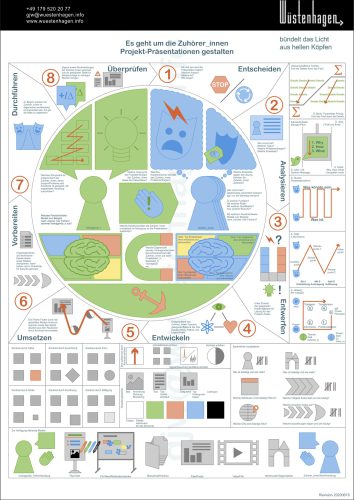Präsentation@GJW:
DE
Big Picture Präsentations-Prozess
Warum: Präsentationen systematisch und ausgerichtet auf die Zuhörenden entwickeln. Das Empfangen bei den Zuhörenden gestalten statt das eigene Senden.
.
Wie: Die acht Prozessschritte systematisch nutzen.
.
Was: Dieses Video dient als Wiederholung von Präsentations-Workshops. Es erläutert den Aufbau des zusammenfassenden Big Pictures. Kern des Big Pictures sind die 8 Schritte auf dem Weg zu einer wirkungsvollen Präsentation. Diese sind: das Treffen der Entscheidung für oder gegen das Erarbeiten einer Präsentation, das Analysieren der Zuhörerschaft, das Entwerfen einer Idee zum Thema, das Entwickeln einer Story, das Umsetzen der Story in die verwendeten Medien, die unmittelbare Vorbereitung, das Durchführen der Präsentation selbst und das Überprüfen der Wirkung.
Schauen wir uns im Detail den ersten Schritt an. Hier entscheiden wir, ob und wer geeignet ist, die Präsentation durchzuführen, um welchen Charakter es sind bei dieser Person handelt und auf welche Weise die Aufmerksamkeit der Zuhörerschaft auf diese Person gerichtet ist.
Im Schritt 2 analysieren wir die Zuhörerschaft. Dabei sammeln wir die spezifischen oder typischen Zuhörerinnen beziehungsweise Zuhörer und deren Sorgen, deren Kopfschmerzen in Bezug auf das Thema. Auch hier schauen wir, um welche Charaktere es sich handelt.
Im Schritt 3 entwickeln wir mittels geeigneter Kreativitätstechniken für diese Sorgen eine Lösungsidee. Mit dieser Lösungsidee formulieren wir auch die eigentliche Handlungsaufforderung an die Zuhörerschaft und sammeln die zu erwartenden Einwände.
Im Schritt 4 entwickeln wir unter Berücksichtigung des bisher gesammelten und der drei zentralen Kanäle in Richtung Zuhörerschaft ein Storyboard. Dabei nutzen und kombinieren wir gängige Erzählkonzepte vom wissenschaftlichen Trichter bis zum drei-Akt-Drama. Idealerweise finden wir einen passenden Anker, an den sich die Zuhörerschaft noch lange nach der Präsentation erinnert. Mit Blick auf die Ausgestaltung wenden wir hier auch Werkzeuge zum Entwickeln von Visualisierungen und Big Picture an.
Im Schritt 5 folgt die Umsetzung. Dazu wählen wir zuerst aus den verfügbaren Medien die geeigneten aus Entwickeln und gestalten diese Medien mit Werkzeugen des Kommunikations- und Graphik-Designs.
Das Vorbereiten im Schritt 6 dient des unmittelbaren Abwägens und Klären technischer und organisatorischer Fragen.
Beim Durchführen der Präsentation im Schritt 7 nutzen wir unsere Improvisationsmöglichkeiten beim Handhaben üblicher Ereignisse während einer Präsentation.
Im letzten Schritt, dem Schritt 8 analysieren wir die Wirkung der Präsentation und ziehen Rückschlüsse für die Entwicklung zukünftiger Präsentationen. Auf diese Weise lässt sich ein persönlicher Stil weiter und weiter entwickeln, denn wir so oft gilt auch hier: Nach der Präsentation ist vor der Präsentation.
EN
Big Picture Presentation Process
Why: Develop presentations systematically and tailored to the audience. Focus on the reception by the audience rather than one’s own transmission.
.
How: Systematically utilize the eight process steps.
.
What: This video serves as a review of presentation workshops. It explains the structure of the summarizing Big Picture. The core of the Big Picture consists of the 8 steps towards an effective presentation. These are: deciding whether or not to develop a presentation, analyzing the audience, designing an idea on the topic, developing a story, translating the story into the media used, immediate preparation, conducting the presentation itself, and assessing the impact.
Let’s delve into the first step in detail. Here, we decide whether and who is suitable to conduct the presentation, what character this person is, and how the audience’s attention is directed towards this person.
In step 2, we analyze the audience. We collect the specific or typical listeners and their concerns, their headaches regarding the topic. Again, we look at what characters they are.
In step 3, we develop a solution idea for these concerns using suitable creativity techniques. With this solution idea, we also formulate the actual call to action to the audience and collect the expected objections.
In step 4, considering what we’ve collected so far and the three central channels towards the audience, we develop a storyboard. We use and combine common narrative concepts from the scientific funnel to the three-act drama. Ideally, we find a suitable anchor that the audience remembers long after the presentation. Regarding the design, we also use tools for developing visualizations and Big Pictures.
Step 5 involves implementation. To do this, we first select the appropriate media from those available and develop and design these media using communication and graphic design tools.
Preparing in step 6 serves immediate consideration and clarification of technical and organizational questions.
During the presentation in step 7, we utilize our improvisational abilities in handling common events during a presentation.
In the final step, step 8, we analyze the impact of the presentation and draw conclusions for the development of future presentations. This way, a personal style can be further developed because as often is the case here too: After the presentation is before the presentation.
Geplante/Erforderliche Verbesserungen
tbd
